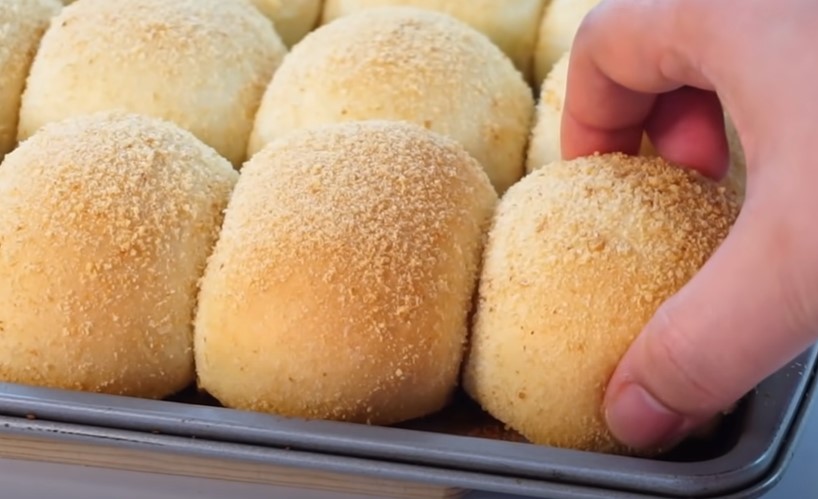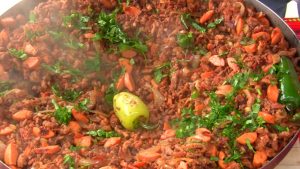Pan de Sal is a classic Filipino bread roll that is typically served for breakfast. It's simple, tasty, and versatile. It's also a great beginner's recipe if you're new to baking bread. Despite its name, which translates to 'bread of salt', it's more sweet than salty because it uses a generous amount of sugar.

All ingredients for this Pan de Sal recipe are fairly common and should be easily found in most supermarkets. The key ingredient is active dry yeast, which is essential for the dough to rise. If it's not available in your local market, you can find it in the baking aisle of any large supermarket or online.
Ingredients for Pan de Sal Recipe
Warm water: This is used to activate the yeast. It should be warm but not hot to the touch.
Active dry yeast: This is a crucial ingredient for any bread recipe as it makes the dough rise.
White sugar: This gives the bread its slightly sweet flavor.
Vegetable oil: It's used to make the dough moist and tender. You can also use other neutral oils.
Salt: This enhances the flavour of the bread.
All-purpose flour: This is the base of the dough. Bread flour can also be used for a chewier texture.
One reader, Karalee Camarillo says:





This pan de sal recipe is a game-changer! The bread turns out soft and fluffy, with a perfect hint of sweetness. The aroma while baking is simply irresistible. I love how easy it is to follow the instructions, and the end result is always a hit with my family. Highly recommended!
Techniques for Crafting the Perfect Pan de Sal
How to activate yeast: Yeast needs to be activated in warm water with a small amount of sugar to help it ferment and rise the dough. It should be left for about 10 minutes until it becomes creamy and frothy.
How to knead dough: Kneading the dough is essential to develop the gluten and create a smooth, elastic texture. It should be kneaded for about 10 minutes on a lightly floured surface until it becomes supple and elastic.
How to shape the dough: After the dough has risen, it should be divided into equal pieces, formed into cylinders, and rolled out to the desired thickness. Then, it should be cut into smaller pieces and shaped into rolls before allowing them to rise again.
How to test for doneness: To ensure the pan de sal is fully baked, it should be golden brown and sound hollow when tapped on the bottom. This indicates that the bread is thoroughly cooked and ready to be enjoyed.
How To Make Pan De Sal
Pan de sal is a Filipino bread roll that’s tender on the inside and crisp on the outside. It’s topped with some crisp bread crumbs too.
Serves:
Ingredients
- 2cupswarm water,(110 degrees F)
- 2tspactive dry yeast
- ⅓cupwhite sugar
- ¼cupvegetable oil
- 1½tspsalt
- 6cupsall purpose flour
Instructions
-
Put the warm water in a small mixing bowl and add the yeast and 1 teaspoon of the sugar; stir to dissolve.
-
Let stand until creamy, about 10 minutes.
-
In a large mixing bowl, combine the remaining 15 teaspoons of sugar and the oil and mix until smooth.
-
Add the salt, 1 cup of flour and the yeast mixture; stir well. Add the remaining 5 cups flour, ½ cup at a time, until the dough pulls away from the sides of the bowl.
-
Turn the dough onto a lightly floured surface and knead for about 10 minutes until smooth, supple and elastic.
-
Lightly oil a large mixing bowl, place the dough in it and turn to coat the dough with oil.
-
Cover with a damp towel or plastic wrap and let sit in a warm place for about 1 hour until the dough has doubled in volume.
-
Turn the dough onto a lightly floured surface and divide into 4 equal pieces. Form each piece into a cylinder and roll out until the ‘log’ is ½ inch in diameter.
-
Using a sharp knife, cut each ‘log’ into ½ inch pieces. Place the pieces, flat side down, onto two lightly greased baking sheets. Gently press each roll down to flatten.
-
Preheat oven to 375 degrees F.
-
Cover the rolls with a damp cloth and let rise for about 30 minutes until doubled in volume.
-
Bake at 375 degrees F for about 20 minutes until golden brown.
Nutrition
- Calories: 116.97kcal
- Fat: 2.13g
- Saturated Fat: 0.16g
- Trans Fat: 0.01g
- Monounsaturated Fat: 1.38g
- Polyunsaturated Fat: 0.42g
- Carbohydrates: 21.41g
- Fiber: 0.75g
- Sugar: 2.29g
- Protein: 2.69g
- Sodium: 105.01mg
- Calcium: 4.39mg
- Potassium: 29.36mg
- Iron: 1.17mg
- Vitamin C: 0.00mg
Technique Tip for Enhancing Your Pan de Sal
When kneading the dough, it's important to use the heel of your hand to push and fold the dough. This technique helps to develop the gluten in the flour, resulting in a bread that is light and airy. Additionally, when letting the dough rise, ensure it's in a warm, draft-free area. This will encourage the yeast to activate and help the dough to double in size. Lastly, when cutting the dough into pieces, try to keep them as uniform as possible. This will ensure even baking and a consistent texture throughout all your pan de sal.
Time-Saving Tips for Pan de Sal Recipe
Prep ahead: Prepare the dough the night before and let it rise in the refrigerator overnight. This will save time in the morning.
Use a stand mixer: Utilize a stand mixer with a dough hook attachment to knead the dough, saving time and effort.
Bake in batches: Instead of baking all the rolls at once, bake in batches to ensure even cooking and save time.
Organize ingredients: Measure and organize all ingredients before starting to streamline the process.
Set a timer: Use a timer to keep track of rising and baking times, allowing you to multitask efficiently.
Preheat oven early: Preheat the oven while the dough is rising to save time in the baking process.
Proper storage: Store the baked pan de sal in an airtight container to keep them fresh for longer, reducing the need for frequent baking.
Substitute Ingredients For Pan De Sal Recipe
warm water - Substitute with milk: Milk can add richness and flavor to the bread, making it softer and more tender.
active dry yeast - Substitute with instant yeast: Instant yeast can be added directly to the dry ingredients without proofing, saving time in the baking process.
white sugar - Substitute with honey: Honey can add a subtle sweetness and moisture to the bread, as well as a hint of flavor.
vegetable oil - Substitute with melted butter: Butter can add a rich and creamy flavor to the bread, enhancing its overall taste and texture.
all purpose flour - Substitute with bread flour: Bread flour has a higher protein content, which can result in a chewier and more structured texture for the bread.
Presenting Pan de Sal: Tips for Serving
Elevate the bread rolls with a touch of elegance: Present the pan de sal on a rustic wooden board or a stone platter to add a touch of warmth and authenticity to the presentation.
Incorporate a visual contrast: Pair the golden-brown pan de sal with a vibrant, fresh herb-infused compound butter to create a striking visual contrast that will captivate the judges' attention.
Emphasize precision: Arrange the pan de sal in a precise, geometric pattern on the serving platter to showcase the chef's attention to detail and dedication to the craft.
Highlight the artisanal quality: Display the pan de sal in a handwoven bread basket lined with a clean, crisp linen napkin to emphasize the artisanal quality and care that goes into creating this classic Filipino bread.
Incorporate natural elements: Garnish the platter with a sprig of freshly picked rosemary or thyme to infuse the presentation with a touch of natural beauty and aromatic appeal.
Create a sensory experience: Serve the pan de sal alongside a small dish of smoked salt to engage the judges' senses and elevate the overall tasting experience.
Emphasize simplicity: Present the pan de sal on a minimalist, modern serving board to highlight the simplicity and purity of this beloved Filipino bread.
Showcase cultural heritage: Incorporate traditional Filipino elements, such as woven banana leaves or indigenous pottery, into the presentation to honor the rich cultural heritage from which the pan de sal originates.
Essential Tools for Making Pan de Sal
- Mixing bowl: A large, round bowl used for mixing ingredients, often made of stainless steel, glass, or plastic.
- Measuring cups and spoons: Essential for accurately measuring ingredients in both liquid and dry form.
- Baking sheets: Flat, rectangular metal sheets used for baking and can be lined with parchment paper or silicone mats.
- Sharp knife: A tool with a sharp blade used for cutting and portioning dough or other ingredients.
- Oven: A kitchen appliance used for baking and heating food items, essential for baking the pan de sal.
- Damp cloth: A clean, damp cloth used for covering the dough while it rises, helping to maintain the right level of moisture.
- Plastic wrap: Used for covering the dough while it rises, helping to create a warm and moist environment for proofing.
- Food processor: Optional for kneading the dough, providing a quick and efficient way to achieve a smooth and elastic texture.
Storing and Freezing Pan de Sal for Later
Here are the detailed storing and freezing guidelines for pan de sal:
- Allow the pan de sal to cool completely on a wire rack before storing or freezing. This will prevent them from becoming soggy or developing condensation.
- To store at room temperature, place the cooled pan de sal in an airtight container or resealable plastic bag. They will stay fresh for up to 3 days at room temperature.
- For longer storage, you can refrigerate the pan de sal in an airtight container or resealable plastic bag for up to 1 week. To reheat, simply microwave for 10-15 seconds or until warmed through.
- To freeze, wrap each pan de sal individually in plastic wrap or aluminum foil, then place them in a freezer-safe container or resealable plastic bag. Label the container or bag with the date and freeze for up to 3 months.
- When ready to eat, remove the desired number of pan de sal from the freezer and let them thaw at room temperature for about 30 minutes. You can also reheat them directly from frozen by placing them in a preheated 350°F (175°C) oven for 5-10 minutes or until heated through.
- For best results, consume the pan de sal within the recommended storage times to ensure optimal freshness and texture.
How To Reheat Leftover Pan de Sal
To reheat leftover pan de sal, preheat your oven to 350°F (175°C). Place the rolls on a baking sheet and cover them loosely with aluminum foil. Bake for 5-7 minutes, or until they are heated through and the crust is slightly crispy. This method helps to restore the texture and freshness of the rolls.
Another option is to use a toaster oven. Set the temperature to 350°F (175°C) and place the pan de sal directly on the rack. Toast for 3-5 minutes, or until they are heated through and the crust is crispy. This method is quick and convenient, especially if you only have a few rolls to reheat.
For a softer texture, you can microwave the leftover pan de sal. Place the rolls on a microwave-safe plate and cover them with a damp paper towel. Microwave on high for 15-20 seconds, or until they are heated through. The damp paper towel helps to prevent the rolls from drying out during reheating.
If you want to add a touch of flavor to your reheated pan de sal, brush them with melted butter or olive oil before reheating. You can also sprinkle them with grated cheese, garlic powder, or herbs for an extra burst of flavor.
For a crispy exterior and a soft interior, you can reheat the pan de sal in a skillet. Heat a small amount of butter or oil in a skillet over medium heat. Add the rolls and cook for 1-2 minutes on each side, or until they are heated through and the crust is crispy.
Interesting Fact About Pan de Sal
Pan de sal is a popular bread roll in the Philippines, often enjoyed as a breakfast staple. It is traditionally coated with breadcrumbs and is best served warm.
Is Making Pan de Sal at Home Cost-Effective?
This pan de sal recipe is highly cost-effective for a household. The ingredients, such as flour, yeast, and sugar, are affordable and commonly found in most kitchens. With a rating of 9/10, this recipe offers great value for money. The approximate cost for a household of 4 people is around $5, making it an economical choice for a delicious homemade treat.
Is Pan de Sal Healthy or Unhealthy?
The pan de sal recipe, while delicious, is not particularly healthy due to its high content of refined flour and sugar. Here's a breakdown of the nutritional concerns:
- Refined all-purpose flour lacks fiber and essential nutrients found in whole grain flours
- High sugar content contributes to excessive calorie intake and potential health issues like diabetes and obesity
- Vegetable oil is often high in unhealthy fats, such as saturated and trans fats
However, the recipe does offer the opportunity to incorporate healthier ingredients and make some simple substitutions to improve its nutritional value without compromising taste.
To make this recipe healthier, consider the following suggestions:
- Replace half or all of the all-purpose flour with whole wheat flour, which is higher in fiber, vitamins, and minerals
- Reduce the sugar content by half or substitute with a natural sweetener like honey or maple syrup
- Use a healthier oil, such as olive oil or coconut oil, which contain beneficial fats like monounsaturated and medium-chain triglycerides
- Incorporate additional healthy ingredients, such as flaxseed meal, chia seeds, or rolled oats, to boost the fiber and nutrient content
- Experiment with adding dried fruits, like raisins or cranberries, to naturally sweeten the bread and provide extra nutrients
By making these adjustments, you can transform the pan de sal recipe into a more wholesome and nutritious bread that still satisfies your cravings for a soft, fluffy, and flavorful treat.
Editor's Opinion: Thoughts on Pan de Sal
This pan de sal recipe is a classic and delightful treat. The instructions are clear and easy to follow, resulting in a soft and fluffy bread with a slightly sweet flavor. The use of warm water and yeast creates a lovely aroma, and the dough's rise time allows for a perfect texture. The end result is a golden brown, crusty exterior with a soft, pillowy interior. This recipe is a wonderful way to bring the warmth and aroma of a bakery into your own home.
Enhance Your Pan De Sal Recipe with These Unique Side Dishes:
Similar Recipes to Try If You Love Pan de Sal
Appetizers and Desserts That Complement Pan de Sal
Why trust this Pan De Sal Recipe:
This recipe for pan de sal is a tried and tested favorite, passed down through generations. The use of active dry yeast ensures a perfect rise, while the addition of vegetable oil creates a soft and tender crumb. The balance of white sugar and salt enhances the flavor, and the gradual addition of all purpose flour guarantees the ideal texture. With meticulous attention to detail and traditional techniques, this recipe promises to deliver authentic and delicious pan de sal every time.
Was this page helpful?
Have your own special recipe to share? Submit Your Recipe Today!












